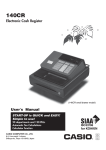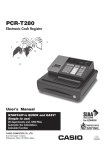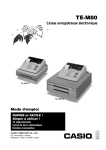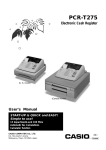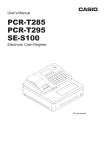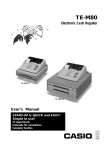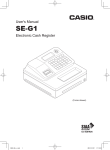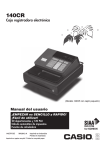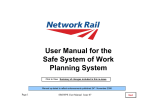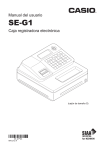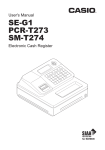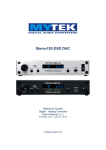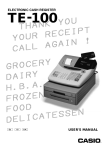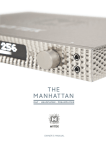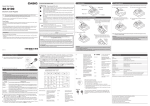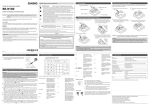Download Casio SE-S10 user manual
Transcript
SE-S10
Electronic Cash Register
(SE-S10 small drawer model)
User's Manual
START-UP is QUICK and EASY!
Simple to use!
20 departments and 500 PLUs
Automatic Tax Calculations
Calculator function
CASIO COMPUTER CO., LTD.
6-2, Hon-machi 1-chome
Shibuya-ku, Tokyo 151-8543, Japan
EU
DI
UK
INTRODUCTION
Thank you very much for purchasing this CASIO electronic cash register.
START-UP is QUICK and EASY!
Part-1 of this User's Manual can help you make a quick start.
Once you have mastered the QUICK START operations, you will undoubtedly want to expand your use of this machine by studying other
sections of Part-2.
Original Carton/Package
If for any reason, this product is to be returned
to the store where purchased, it must be
packed in the original carton/package.
Power Supply
Your cash register is designed to operate
on standard household current (120V, 220V,
230V or 240V; 50/60Hz). Do not overload the
outlet by plugging in too many appliances.
Location
Locate the Cash register on a flat, stable surface, away from heaters or areas exposed to
direct sunlight, humidity or dust.
Cleaning
Clean the cash register exterior with a soft
cloth which has been moistened with a solution of a mild neutral detergent and water, and
wrung out.
Be sure that the cloth is thoroughly wrung out
to avoid damage to the printer.
Never use paint thinner, benzene, or other
volatile solvents.
The mains plug on this equipment must be used to disconnect mains power.
Please ensure that the socket outlet is installed near the equipment and shall be easily
accessible.
E
2
INTRODUCTION
Safety precautions
• To use this product safely and correctly, read this manual thoroughly and operate as instructed.
After reading this guide, keep it close at hand for easy reference.
Please keep all informations for future reference.
• Always observe the warnings and cautions indicated on the product.
About the icons
In this guide various icons are used to highlight safe operation of this product and to prevent injury to the operator and
other personnel and also to prevent damage to property and this product. The icons and definitions are given below.
Indicates that there is a risk of severe injury or death if used incorrectly.
Indicates that injury or damage may result if used incorrectly.
Icon examples
To bring attention to risks and possible damage, the following types of icons are used.
The
symbol indicates that it includes some symbol for attracting attention (including warning). In this triangle the
actual type of precautions to be taken (electric shock, in this case) is indicated.
The symbol indicates a prohibited action. In this symbol the actual type of prohibited actions (disassembly, in this
case) will be indicated.
symbol indicates a restriction. In this symbol the type of actual restriction (removal of the power plug from an
The
outlet, in this case) is indicated.
Warning!
Handling the register
Should the register malfunction, start to emit smoke or a strange odor, or otherwise behave abnormally,
immediately shut down the power and unplug the AC plug from the power outlet. Continued use creates the
danger of fire and electric shock.
• Contact CASIO service representative.
Do not place containers of liquids near the register and do not allow any foreign matter to get into it. Should
water or other foreign matter get into the register, immediately shut down the power and unplug the AC plug
from the power outlet. Continued use creates the danger of short circuit, fire and electric shock.
• Contact CASIO service representative.
Should you drop the register and damage it, immediately shut down the power and unplug the AC plug from
the power outlet. Continued use creates the danger of short circuit, fire and electric shock.
• Attempting to repair the register yourself is extremely dangerous. Contact CASIO service representative.
Never try to take the register apart or modify it in any way. High-voltage components inside the register create
the danger of fire and electric shock.
• Contact CASIO service representative for all repair and maintenance.
Power plug and AC outlet
Use only a proper AC electric outlet. Use of an outlet with a different voltage from the rating creates the danger
of malfunction, fire, and electric shock. Overloading an electric outlet creates the danger of overheating and
fire.
Make sure the power plug is inserted as far as it will go. Loose plugs create the danger of electric shock,
overheating, and fire.
• Do not use the register if the plug is damaged. Never connect to a power outlet that is loose.
E
3
INTRODUCTION
Warning!
Use a dry cloth to periodically wipe off any dust built up on the prongs of the plug. Humidity can cause poor
insulation and create the danger of electric shock and fire if dust stays on the prongs.
Do not allow the power cord or plug to become damaged, and never try to modify them in any way. Continued
use of a damaged power cord can cause deterioration of the insulation, exposure of internal wiring, and short
circuit, which creates the danger of electric shock and fire.
• Contact CASIO service representative whenever the power cord or plug requires repair or maintenance.
Caution!
Do not place the register on an unstable or uneven surface. Doing so can cause the register — especially
when the drawer is open — to fall, creating the danger of malfunction, fire, and electric shock.
Do not place the register in the following areas.
• Areas where the register will be subject to large amounts of humidity or dust, or directly exposed to hot or cold air.
• Areas exposed to direct sunlight, in a close motor vehicle, or any other area subject to very high temperatures.
The above conditions can cause malfunction, which creates the danger of fire.
Do not overlay bend the power cord, do not allow it to be caught between desks or other furniture, and never
place heavy objects on top of the power cord. Doing so can cause short circuit or breaking of the power cord,
creating the danger of fire and electric shock.
Be sure to grasp the plug when unplugging the power cord from the wall outlet. Pulling on the cord can
damage it, break the wiring, or cause short, creating the danger of fire and electric shock.
Never touch the plug while your hands are wet. Doing so creates the danger of electric shock. Pulling on the
cord can damage it, break the wiring, or cause short, creating the danger of fire and electric shock.
At least once a year, unplug the power plug and use a dry cloth or vacuum cleaner to clear dust from the area
around the prongs of the power plug.
Never use detergent to clean the power cord, especially power plug.
Keep small parts out of the reach of small children to make sure it is not swallowed accidentally.
Disposing of batteries:
Make sure that you dispose of used batteries in accordance with the rules and regulations in your local area.
E
4
Contents
Getting to know your cash register ....................................................................
Daily Job Flow ...................................................................................................
Part-1
1.
2.
3.
4.
5.
6.
7.
8.
9.
10.
1.
2.
9
9
10
10
11
11
11
12
14
18
20
CALCULATOR FUNCTION .............................................................
43
Calculator Mode.......................................................................................... 43
Part-4
1.
2.
CONVENIENT OPERATION ............................................................
9
Various Programming ................................................................................. 20
Various Operations ..................................................................................... 37
Part-3
1.
QUICK START OPERATION ...........................................................
Loading Memory Protection Battery ...........................................................
Loading Paper Roll .....................................................................................
Setting the Cash Register ...........................................................................
If you want to use a printer as journal printer .............................................
To remove receipt paper .............................................................................
To remove journal paper .............................................................................
Caution (in handling the thermal printer) ....................................................
Basic Programming for QUICK START .......................................................
Basic Operation after Basic Programming ..................................................
Daily Management Report ..........................................................................
Part-2
6
8
USEFUL INFORMATION .................................................................
45
Troubleshooting .......................................................................................... 45
Specifications.............................................................................................. 46
Basic Components and Accessories
Printer cover
Operator display
Mode switch
Accessories
Roll paper
Mode keys
Drawer keys
User's manual
Fixing hook
(M drawer model only)
Magnetic plate*
Keyboard
Drawer
(SE-S10 small drawer model)
1 pc
2 pcs
1 pc
2 pcs
1 pc
* Use this plate for tacking the notes
received from customer.
Weld lines
Lines may be visible on the exterior of the product. These are “weld lines” that result from the plastic molding process.
They are not cracks or scratches.
E
5
Getting to know your cash register
Getting to know your cash register
Mode Switch
REG
CAL X
OFF
RF
The position of the Mode Switch controls the type of operations you
can perform on the cash register. The PROGRAM key (marked PGM)
can be select any Mode Switch setting, while OPERATOR key (marked
OP) can be used to select OFF, REG or CAL only.
Z
PGM
OP
PGM RF OFF REG CAL X Z
OP key ●
●
●
PGM key ● ● ●
●
● ● ●
OFF
In this position, the power of the cash register is off.
REG (Register)
This is the position used for registration of normal transactions.
RF (Refund)
This is the position used for registration of refunds.
CAL (Calculator)
This is the position used for calculator mode.
PGM (Programming)
This is the position used to program the cash register to suit the
needs of your store.
X (Read)
This is the position used to produce reports of daily sales totals without clearing the totals.
Z (Reset)
This is the position used to produce reports of daily sales totals. This
setting clears the totals.
PGM
OP key PGM key
Note:
An error is generated (E01 displayed)
whenever the position
of the Mode Switch is
changed during registration.
Display
Operator display
Customer display
4
$
1
%
�*12345&78
!
#
2
#
12345&78
$Numeric Display
Entered values (unit prices or quantities) and
calculated
values (subtotals, totals or change
!Department Number Display
amount
due)
are displayed here. The capacity of
Anytime you press a department key to register a
unit price, the corresponding department number the display is 8 digits.
This part of the display can be used to show the
appears here.
current
time or date between registrations (page
@PLU Number Display
40).
Anytime you perform a PLU registration, the cor%Character Display
responding PLU number appears here.
#Number of Repeat Display
In the character programming (P2) mode, it shows
Anytime you perform “repeat registration” (page the last entered character.
14), the number of repeats appears here.
The total (T) or change (C) appears when a subtotal,
Note that only one digit is displayed for the num- total, or change is obtained.
ber of repeats.
In the paper saving mode, it shows *.
@
E
6
Getting to know your cash register
Keyboard
G
H
PAPER
SAVING
1
FEED
D
I
POST
TAX PGM
RECEIPT
2
3
×
DATE
TIME
AC
8
9
4
5
6
1
2
HELP
4—
C
7
• Department 6 through 20 are specified by
pressing the j key respectively as follows:
J
5
ERR.
CORR
F
4
5
9/14/19
10/15/20
÷
×
3
E
0 00 .
PLU
−
+
3
6
7
# DEPT %
SHIFT
8
MR
0
8/13/18
2
B
7/12/17
1
C
6/11/16
RC
CH
CLK#
9
PD
j
jj
CA AMT
TEND
=
~j
~jj
jjj
→ Department
6 ~ 10
→ Department
11 ~ 15
→ Department
16 ~ 20
~ jjj
PAPER
G
SAVING Paper saving key
Paper saving key is the key to save printing
paper (Journal compressed printing/ No re
ceipt issuing). In these cases, "*" is lit on the
character display.
A
CHK
NS
SUB TOTAL
H
< Post receipt key
Post receipt key is used for issuing receipt
after transaction. This key is effective if the
printer is defined as printing receipts. Refer
to page 38.
Certain keys have two functions; one for register
mode and one for calculator mode.
~ Tax Program key
In this manual, we will refer to specific keys as I
noted below to make the operations as easy to J
/ Help key
understand as possible:
Help key is used for issuing assistant receipts such as programming date/ time,
Register Mode
paper installation etc.
1 l
Feed key
2
h Multiplication/ Date Time key
3
y Clear key
4
g Minus/ Error Correction key
5
i PLU (Price Look Up) key
6
j Reference Number/Department Shift key
7: Percent/Cashier ID No. Assignment key
8
. Received on Account key
9
; Paid Out key
0
u Charge key
A
m
B
Check/No Sale key
Subtotal key
C
p Cash Amount Tendered key
Calculator Mode
3
t AC key
7
: Percent key
8
/ Memory Recall key
A
m
Drawer Open key
C
p Equal key
D
?, Z, ~ >, '
Numeric keys and 2-zero key
E
"
Decimal key
F
,
,
,
Arithmetic Operation key
D
?, Z, ~ >, '
Numeric keys and 2-zero key
E
"
Decimal key
F
,
,
,
,
Department keys
E
7
Daily Job Flow
Daily Job Flow
Before Opening The Store
1. Plugged in?
2. Enough Roll Paper?
Page-11
3. Date and Time is correct? Page-40
4. Enough small change in the drawer?
Page-41
While The Store Is Open
1. Registrations.
Page-14 ~
2. Issuing latest daily sales total if needed.
(Generating report by Mode Switch to
X position.)
Page-18
After Closing The Store
1. Issuing Daily Sales Total.
(Resetting report by Mode Switch to
Z position.)
Page-19
2. Picking up money in the drawer.
Page-41.
Turn the Mode Switch to OFF.
Other
1. Troubleshooting
E
8
Page-45
Part-1 QUICK START OPERATION
Part-1
QUICK START OPERATION
1. Loading Memory Protection Battery
Part-1
Important
You must initialize
the Cash register.
1. Remove the printer cover.
2. Open the battery compartment cover.
3. Load 2 new UM-3, or R6P (SUM-3) type batteries into the
compartment. Be sure that the plus (+) and minus (–) ends
of each battery are facing in the directions indicated by the illustrations inside the battery compartment (Figure 1).
4. Replace the memory protection battery compartment cover
back into place.
(Figure 1)
· Note:To prevent to lose all of your settings and sales data, we recommend you to install
the memory protection batteries.
· REPLACE MEMORY PROTECTION BATTERIES AT LEAST ONCE EVERY YEAR.
2. Loading Paper Roll
To load receipt paper
!Open platen arm.
printer.
@Ensuring the paper is being fed from the bot-
tom of the roll, lower the roll into the space
behind the paper.
#Put the leading end of the paper over the
$ Close the platen arm slowly until it locks
steadily.
Caution
Risk of explosion if battery is replaced by an incorrect type.
Dispose of used batteries according to the instructions.
E
9
Part-1
QUICK START OPERATION
3. Setting the Cash Register
! Plug the power cord of the cash register into AC outlet.
@ Please choose your language followed by printed message.
# When the display shows blinking "0", such as
00-00-00
Enter current date in Day, Month, Year.
$ When the display shows blinking "0", such as
00-00
Enter current time in Hour, Minute.
% Set the mode switch to REG.
^ Tear off any excess paper.
& Replace the printer cover slowly.
*Default printer definition is receipt printer.
4. If you want to use a printer as journal printer
! Set printing system as journal.
REG
CAL X
$ Roll the paper onto the take up real a few turns.
Z
OFF
RF
PGM
Z
Zu
@ Remove the printer cover by lifting up the back.
# Press the l key until approximately 20cm of the
paper is fed from the register.
E
10
% Set the left plate of the take up need and place the
reel into the register.
^ Press the l key to take up any slack in the paper.
& Replace the printer cover slowly.
Part-1 QUICK START OPERATION
5. To remove receipt paper
! Open the platen arm.
Part-1
@ Remove the core of the paper.
6. To remove journal paper
!Remove the printer cover by $Remove the take-up reel &
Remove the core of the pa-
lifting up the back.
from the printer and take off
the left plate of the reel.
%Remove the journal paper
from the take-up reel.
@Press the l key until ap- proximately 20cm of the paper is fed from the printer.
#Cut off the roll paper.
^Open the platen arm.
per.
*Load new paper following the
instructions "1. To load journal paper".
7. Caution (in handling the thermal printer)
1. Never touch the printer head and platen.
2. Unpack the paper just before you use.
3. Avoid heat/ direct sunlight.
4. Avoid dusty and humid places for strage.
5. Do not scratch the paper.
6. Do not keep the paper under the following circumstances: High humidity and temperature/ direct
sunlight/ contact with glue, thinner or rubber eraser.
E
11
Part-1
QUICK START OPERATION
8. Basic Programming for QUICK START
Mode Switch
REG
CAL X
Z
OFF
RF
PGM
Procedure
1. To select the date format and monetary mode (if necessary)
You can select the date format and monetary mode after initialization depending on
the requirements in your area. Default date format is Day/ Month/ Year and default
monetary mode is add 2.
C
Date Format Selections
P3 appears in mode display
?ZXX
A
Program set code No.
X?
p
Select number from list A
Select number
from list B
(To end the setting)
Year/ Month/ Day
?
Day/ Month/ Year
Z
Month/ Day/ Year
X
Purpose
Select date format
and
monetary mode
Monetary Mode Selections
Add 0
(0.)
?
B
Add 1
(0.0)
Z
Add 2
(0.00)
X
2. Input the desired add-in tax rate to the appropriate department key.
(This procedure below programs add-in tax rate only. If you want to set add-on tax
or tax with special rounding, refer to page 27 of this manual.)
A)Enter 1 and press the
key.
B)Press the ~ key.
C)Enter tax rate. (Example: For 6% enter “6”, 5.75% enter “5.75”.)
D)Press the appropriate department key.
E)Repeat step B) and C) to set other department key.
F)Press the
key to end tax programming.
Note:In case of setting the wrong tax rate to the key, please enter ? and press
Setting the tax rates
key,
those department keys above, and quit this procedure by pressing
and start from the beginning of this procedure.
Example :
Set add-in tax 8% to department 2, 3, 15% to department 4 key.
Start tax program.
~
8
Enter tax rate and press dept key.
8
Enter tax rate and press dept key.
15
Enter tax rate and press dept key.
E
12
To end the setting.
Part-1 QUICK START OPERATION
(to end the setting)
(4) Main currency = Euro, Print out subtotal = Both : C
Purpose
Part-1
Procedure
3. In case of accepting two (the Euro and the local) currencies.
3-1. Press the following keys to define the main currency/print out currency of the
subtotal.
C
P3
appears
in
mode
display
XVXX
Euro status
Z
p
(1) Main currency = Local, Print out subtotal = Local: ?
Euro Status
(2) Main currency = Euro, Print out subtotal = Euro : Z
(3) Main currency = Local, Print out subtotal = Both: X
Setting the Euro
3-2. Press the following keys to set the currency exchange rate against the Euro.
Z
P appears in mode display
Z"B>;
(To end the setting)
Example: (Exchange rate and decimal position)
Currency exchange rate = 1 Euro in local currency
1 Euro = 1.95583 DM : Z>BB<CB
•The rate within the range of 0.00001 to 999999.
4. In case of becoming to accept the Euro only.
You can restrict the registable currency to the Euro only by the following procedure.
Restricting the Cur1. Turn the mode switch to Z position.
rency
2. Issue all reset report including periodic data.
3. Press the following keys to set. ?Z?MX??X
p
to the Euro
.
If you want to cancel this operation, press
instead of p
5.For Australia only.
You can set some programmable options to suit the Australian GST by the following
procedure.
1. Turn the mode switch to Z position.
2. Press the following keys to program. ?Z?ZX??Z
p
If you want to cancel this operation, press
instead of p.
Setting the
Australian GST
E
13
Part-1
QUICK START OPERATION
9. Basic Operation after Basic Programming
Mode Switch
REG
Note:
Whenever an error is generated, the input figures reset to 0. All printout
samples are journal images and the header (date, time and consecutive
no.) are eliminated from the samples.
m
Z??
Unit Price Department 1
Example
Unit Price $1.00 $2.00 $0.30 jX??
1
1
1
10
1
15
$5.00
08-01-2010
REG
NS
9-2 Basic operation
Quantity
Dept.
Cash
Amount
tendered
Z
OFF
RF
PGM
Printout
Operation
9-1 Open the drawer
without a sale
CAL X
08-01-2010
REG
DEPT01
DEPT10
Department 10 DEPT15
TOTAL
jjC?
CASH
Department 15 CHANGE
B??
p
08:55
0001
•••••••••• —No Sale Symbol
09:00
0002
•1.00—Department No./Unit Price
•2.00
•0.30
•3.30—Subtotal
•5.00—Cash Amount Tendered
•1.70—Change Amount Due
Cash amount tendered
Departments 6 through 10, 11 through 15, 16 through 20 can also be registered in combination with the j and
,
,
,
or
keys, respectively. The j key should be entered just before entering unit price manually.
9-3 Multiple registration of the same
items
Example
Unit Price
Quantity
Dept.
$1.00
2
1
$1.35
3
2
Z??
Department 1
08-01-2010
REG
Unit Price
C
h
DEPT01
•1.00
DEPT01
•1.00—Repeat
—Sales Quantity/ Unit Price
3 X @1.35
DEPT02
•4.05
CASH
•6.05
Quantity
Multiple key
ZCB
p
09:05
0003
Note that repeat registration can be used with unit prices up to 6 digits long.
9-4 Charge sales
Z??
X??
Example
Unit Price $1.00 $2.00 $3.00 C??
Quantity
1
1
1
Dept.
1
2
1
u
08-01-2010
REG
DEPT01
DEPT02
DEPT01
CHARGE
09:10
0004
•1.00
•2.00
•3.00
•6.00—Charge Sales
Charge key
You cannot perform the amount tendered operation using the u key.
E
14
Part-1 QUICK START OPERATION
9-5 Split cash/
charge sales
Example
$2.00 $3.00 $4.00
1
1
1
1
2
1
$5.00
9-6 Corrections
9-6-1 Before you
press a department key
Example
1. Entered 400 for unit
price by mistake instead of 100.
X??
C??
V??
B??
p
u
DEPT01
DEPT02
DEPT01
TOTAL
CASH
CHARGE
09:25
0005
•2.00
•3.00
•4.00
•9.00
•5.00—Cash Amount Tendered
•4.00—Charge Sales
Corrections can be made while you are registering the item (before
you press a department key), or after it has already been registered into the memory (by pressing a department key).
y key
clears the last item entered.
Printout
Operation
V??
y
Wrong entry
DEPT01
•1.00
Clears the last item entered.
Z??
Correct entry
2. Entered unit price first
instead of quantity
and then pressed h.
08-01-2010
REG
Part-1
Unit Price
Quantity
Dept.
Cash
Amount
tendered
Printout
Operation
Registered Department 1
h
X??
Unit price
Multiplication
5 X @2.00
DEPT02
•10.00
y
Clears the last item entered.
B
h
Quantity Multiplication
X??
Unit price
3. Entered 150 for unit
price by mistake instead of 105.
Registered Department 2
Z?
h
Quantity
Multiplication
10 X @1.05
DEPT03
•10.50
ZB?
y
Wrong entry
Clears the last item entered.
Z?
h
Quantity
Z?B
Correct entry
Registered Department 3
E
15
Part-1
QUICK START OPERATION
Mode Switch
REG
CAL X
Z
OFF
RF
9-6-2 After you
pressed a
department key
Example
1. Entered unit price 550 by
mistake instead of 505 and
pressed a department key.
PGM
Printout
Operation
g key cancels the last registered item.
BB?
Wrong entry
g
DEPT01
ERR CORR
DEPT01
•5.50
-5.50
•5.05
Cancels the last item registered.
B?B
Correct entry
Registered Department 1
2. Entered unit price 220 by
mistake instead of 230
and pressed a department key.
C
h
Quantity Multiplication
XX?
Wrong entry
g
Cancels the last item registered.
C
h
XC?
Correct entry
E
16
Registered Department 2
3 x @2.20
DEPT02
•6.60
ERR CORR
-6.60
3 X @2.30
DEPT02
•6.90
Part-1 QUICK START OPERATION
9-7 Registering with
currency exchange
Mode Switch
REG
CAL X
Z
OFF
RF
Unit Price
£2.00
Quantity
3
Dept. 1
1
Cash Amount
10.00 Euro
tendered
Rate
1Euro = £ 0.8
Main currency
Local (£)
Printout of ST Both currencies
Part-1
Example
PGM
Display
Operation
C
h
X??
;
'50e
Pressing ] before subtotal converts the
subtotal amount into the Euro.
Z?'
;
1~00e
"00
Pressing ; after amount tendered
converts the amount into the Euro. *1
p
Press p to finalize the transaction.
The change amount in the main currency
is shown on the display. *2
*1 If the payment is the same as the subtotal amount, you can omit this
operation. Press p key directly after the subtotal.
*2If the payment is less than the subtotal amount, the cash register
specifies it as a partial payment and shows the balance in the main
currency on the display.
Printout
08-01-2010
REG
09:30
0010
3 x @2.00
DEPT01
•6.00
TOTAL
•6.00 —Subtotal in the main currency
⁄7.50 —Subtotal after conversion
—Payment in the Euro
EURO
⁄10.00
CASH
CASH
•8.00 —Payment after conversion
CHANGE
•2.00 —Change in the main currency
⁄2.50 —Change in the sub currency
EURO CG
E
17
Part-1
QUICK START OPERATION
10.Daily Management Report
This section tells you the procedures to use to produce reports of the transaction data stored in the
cash register's memory.
Important
Remember that when you issue a reset (Z) report, the data that is reported is cleared from
the applicable totalizers. To view data without clearing totalizers, issue a read (X) report.
10-1Financial Report
Mode Switch
REG
CAL
XZ
h
08-01-2010
X
19:10
0070
—Read Symbol
FLASH X
GROSS TOTAL
NET TOTAL
CASH-INDW
CHARGE-INDW
CHECK-INDW
OFF
RF
Printout
Operation
PGM
QT 57—Gross Sales No. of items
•270.48—Gross Sales Amount
No 38—Net Sales No. of Customers
•271.24—Net Sales Amount
•197.57—Cash Total in Drawer
•18.19—Charge Total in Drawer
•45.18—Check Total in Drawer
10-2 Read/Reset
Report
10-2-1 Electronic
journal Report
Operation
Mode Switch to X
B<p
Printout
10-01-2010
X
(Date)*
p
(Consecutive No.)*
p
0058 EJ
REG
DEPT01
CA
19:25
0173
X
17:34 —Journal
0023
•2.24
•2.24
* If you want to designate read range, enter date and/ or cosecutive No..
If you want to reset the electronic journal, just press B<p in Z mode.
• Journal is saved in the memory and you can take a report any time you want.
E
18
—Read Symbol
Part-1 QUICK START OPERATION
Mode Switch to Z
Z (Reset) report
(Read) p
(Reset) p
Mode Switch
REG
CAL X
Z
OFF
RF
19:25—Date/Time
0073—Consecutive No.
08-01-2010
Z
PGM
X (Read) report is the same except *1 and *2.
0000 DAILY
No. of
Z 0012—Non-resettable
*1
Resets /RESET Symbol *1
DEPT01 QT
48—Dept. Name/ No. of Items
•50.10—Amount
Part-1
Mode Switch to X
Printout
Operation
10-2-2Daily Read/Reset
Report
DEPT02
QT
28
•76.40
DEPT03 QT
17
•85.80
DEPT20 QT
4
•3.00
-----------------------GROSS TOTAL
QT
108—Gross Sales No. of Items
•316.80—Gross Sales Amount
NET TOTAL
No 46—Net Sales No. of Customers
•325.13—Net Sales Amount
CASH-INDW
•199.91—Cash in Drawer
CHARGE-INDW
•16.22—Charge in Drawer
CHECK-INDW
•105.00—Check in Drawer
TA1
•105.10—Taxable Amount for Tax Rate 1
TAX1
•4.20—Tax Amount for Tax Rate 1
ROUNDING AMT
•1.23—Rounded Amount
RF-MODE TTL
No
2—Refnd Mode Count
•0.50—Refund Mode Amount
CALCULATOR
No 3—No. of p key operation in CAL mode
-----------------------CASH
No 44—Cash Sales Count
•203.91—Cash Sales Amount
CHARGE
No 3—Charge Sales Count
•16.22—Charge Sales Amount
CHECK
No
2—Check Sales Count
•105.00—Check Sales Amount
RC
•6.00—Received On Account Amount
PD
•10.00—Paid Out Amount
-
•0.50—Reduction Amount
%-
•0.66—Premium/Discount Amount
ERR CORR
No
21—Error Correction Count
NS
No
12— No sale Count
-----------------------CLERK01
•325.13—Clerk 1 Sales Amount
------------------------ (Refer to 2-8 Cashier Assignment)
GT
•0,000,832,271.20—Non-resettable Grand Sales total
(Printed only on RESET report) *2
10-2-3 Periodic Read/
Reset Report
Mode Switch to Z
Operation
Printout
12-01-2010
Z
or
X
Z?p
0010 PERIODIC
20:25
1100 —Periocic Reset Symbol
ZZ 0001 —Gross Sales No. of Items
—Gross Sales Amount
GROSS TOTAL
NET TOTAL
QT 67 —Net Sales No. of Customers
•270.73 —Net Sales Amount
No 38
•271.24
E
19
Part-2
CONVENIENT OPERATION
Part 2
CONVENIENT OPERATION
Mode Switch
REG
1. Various Programming
Unit Price
Dept.
Z
OFF
1-1 Unit price for Departments
Example
CAL X
RF
PGM
Z
$1.00 $2.20 $11.00
1
2
3
P appears in mode display
Z??
XX?
ZZ??
(For Dept. 1)
(For Dept. 2)
(For Dept .3)
•Unit prices within the range of 0.01~9999.99.
1-2 Rate for percent key
Example
Discount Rate
2.5%
Z
P appears in mode display
X"B
:
(To end the setting)
•The rate within the range of 0.01 to 99.99%.
1-3 To change tax status
for Departments
P appears in mode display
Example
Status
Depts.
Tax status for the Departments 1 ~ 20 are initialized as Non-Taxable.
Z
~
Taxable 1 Taxable 2
1
7
.
Select key from list A For Dept. 1
j;
Taxable status 2
For Dept. 7
(To end the setting)
Selections
Taxable status 1
Taxable status 2
;
Taxable status 3
h
4
u
E
20
.
Taxable status
Non-taxable
status
m
A
Part-2 CONVENIENT OPERATION
1-4 Status for Department
Mode Switch
REG
Example
Depts.
1
2
CAL X
Z
OFF
Selections
A
B
C
0
4
1
0
5
1
RF
PGM
C
P3 appears in mode display
?VZ For Dept. 1
Select a number
from list A
Select a number
from list B
Select a number from list C
?BZ For Dept. 2
Normal
department
Maximum No. of
digits to be 5
Single item sale department
Part-2
(To end the setting)
Selections
Normal department
?
Minus department
Z
No limitation for manually entered price.(7digits)
Maximum number of digits for manually entered price.
?
Z~M
(1 ~ 7 digits)
A
B
< or >
To prohibit manual price entries.
Normal sales (not a single-item sale) department
?
Set as a single-item sale department
Z
C
1-5 Status for percent key
1-5-1 To change taxable status The percent key is initialized as Non-taxable.
for the percent key
Z
~
P appears in mode display
Example
.:
Change Percent key registration as a Taxable status 1.
Select key from list A (For percent key)
(To end the setting)
Selections
.
Taxable status 1
Taxable status 2
;
Taxable status 3
h
Taxable status 4
u
All taxable status (1, 2, 3 and 4)
status
Non-taxable
A
.;
m
E
21
Part-2
CONVENIENT OPERATION
1-5-2 Status for
percent key
C
Example
P3 appears in mode display
Round
Percent
Up
%+
ZZ
:
Select a number from list A Select a number from list B
(To end the setting)
Selections
Rounding of results produced by Percent Key operation.
Round off (1.544=1.54; 1.545=1.55)
?
Cut off (1.544=1.54; 1.545=1.54)
Z
Round up (1.544=1.55; 1.545=1.55)
X
Program Percent Key to register discounts (%–). ?
Program Percent Key to register premiums (%+). Z
1-6 Taxable Status
for minus key
A
B
The minus key is initialized as Non-taxable.
Z
~
P appears in mode display
Example :
.g
Change minus key registrations as a
Taxable status 1.
Select key from list A
Minus key
(To end the setting)
Selections
E
22
.
Taxable status 1
Taxable status 2
;
Taxable status 3
h
Taxable status 4
u
All taxable status (1, 2, 3 and 4)
Non-taxable status
.;
m
A
Part-2 CONVENIENT OPERATION
1-7 General features
Mode Switch
REG
1-7-1 To set general
controls
CAL X
Z
OFF
C
RF
PGM
P3 appears in mode display
?NXX
Program code No.
Select a number from list A
????
p
(To end the setting)
Select a number from list B
Select a number from list C
Select a number from list D
Yes
No
No
Yes
No
Yes
?
X
V
N
Selections
Time displays with second.
Allow split cash amount tendered.
Allow split check amount
tendered.
A
Yes
Yes
No
Selections
Maintain key buffer during receipt issue
in REG mode.
Reset the consecutive number
to zero whenever a Daily Reset
Report is issued.
Allow credit balance registration.
Yes ?
Yes
No
Z
No
Yes X
No
No
C
Yes V
Yes
No
B
Yes
Yes N
No
No
M
B
Yes
No
No
No
Yes
No
Yes
No
Yes
No
Yes
No
Yes
No
Yes
Yes
C
Selections
Use the ' key as a 000 key.
Cashier assignment systems (sign
on) is used.
Limit the last 1 digit of total
amount to 0 and 5 when Malaysian rounding is specified
for subtotal and total amount.
No
?
Z
X
C
V
B
N
M
Part-2
Selections
Limit the last 2 digits of total amount to 00
and 50 when Danish rounding is specified
for subtotal and total amount.
Key catch tone.
No
Yes
No
Yes
No
Yes
No
Yes
?
Z
X
C
V
B
N
M
D
E
23
Part-2
CONVENIENT OPERATION
1-7-2 To set printing
controls
C
P3 appears in mode display
?BXX
Program code No.
????
p
Select a number from list A
Always “0”
Select a number from list B
Select a number from list C
(To end the setting)
Selections
Use the printer to print receipts = R
Use the printer to print a journal = J
Print receipt by single/ double
height characters.
Print Total line at finalization
Single
No
Double
Single
Yes
Double
Selections
Print the time on the receipt and journal.
Yes
No
R
J
R
J
R
J
R
J
?
Z
X
C
V
B
N
M
A
No
Yes
No
Yes
Yes
24
B
Selections
Print the consecutive number on the
receipt/journal.
Print the subtotal on the receipt/
journal when the Subtotal Key is
pressed.
Skip item print on journal.
No
E
?
V
Yes
No
Yes
No
Yes
No
Yes
No
?
Z
X
C
V
B
N
M
C
Part-2 CONVENIENT OPERATION
1-7-3 To set report
printing controls
Mode Switch
REG
C
CAL X
Z
OFF
P3 appears in mode display
RF
?<XX
PGM
Program code No.
???
p
Select a number from list A
Select a number from list B
Select a number from list C
(To end the setting)
Selections
Clear electronic journal memory after
Daily Reset Report.
?
Z
A
Print zero-total line on the Read/Reset
Reports
Print the grand sales total on the
Reset Reports.
Yes
Selections
Print RF switch mode refund count/
amount on the Daily Read/Reset Reports.
Yes
No
1-7-4 Printer switch for
Receipt or Journal
Example
To print a journal
No
?
Z
No
Yes
No
Yes
?
Z
X
C
Part-2
Yes
No
Selections
C
B
The printer is initialized as receipt.
Z
P appears in mode display
Z
u
Select a number from list A
1-7-5 Receipt printing character/
key catch tone Selections
Use the printer to print receipts.
?
Use the printer to print a journal. Z
A
•Printer selection to print a journal or
receipts can also be set on procedures
1-7-2 “To set printing controls”.
Z
P appears in mode display
Z?X??
Z
p
Z?<??
Z
p
Selections
Print receipt with single height.
?
Print receipt with double height.
Z
Selections
Key catch tone
?
No key catch tone
Z
A
B
E
25
Part-2
CONVENIENT OPERATION
1-8 PLU setting
1-8-1 Linkage with
Departments
C
P3 appears in mode display
Example
PLU No.
Link dept. No.
1
4
100
4
ZiV
p
PLU No. Select number from list A
Z??
i
PLU No.
V
p
Dept. No. to be linked
(To end the setting)
Selections
Linked to dept. 20.
?
Linked depts. 1~20 respectively. Z~ X?
A
•500 PLUs can be set.
•When the linked department is not specified, the
PLU is linked to department 20.
•Status for a single-item sale and tax status are
followed the specified linked department.
1-8-2 Unit Prices
for PLUs
Example
PLU No.
Unit Price
1
2
$1.00 $3.00
Z
P appears in mode display
Z
i
PLU No.
Z??
p
Unit Price
X
i
PLU No.
C??
p
Unit Price
(To end the setting)
•Unit prices within the range of $0.01~9999.99.
E
26
Part-2 CONVENIENT OPERATION
C
1-9 Setting the
Tax Rate
and rounding
P3 appears in mode display
?ZXB
Program set code No. for tax rate 1*1
??"????
p
Enter tax rate A
????
p
Select numbers from list B
Select number from list D
Select number from list C
•You can use either an
add-on rate tax or an
add-in rate tax (VAT),
depending on the
requirements in your
area. You can specify
only one tax rate.
•The normal rounding
specification tells the
cash register how to
round tax amounts to
the proper number of
decimal places.
•The special rounding specification and
Danish rounding tell
the cash register how
to round off subtotals
and totals so that their
rightmost 2 digits are
00 and 50.
•Note that the rounding specification you
program for your cash
register depends on
the tax laws of your
country.
(To end the setting)
Tax rate specifications
The tax rate within the range of 0.0001 ~
99.9999%. Use " key for decimal point.
Normal rounding specifications
Cut off to 2 decimal places.
??
(1.544=1.54; 1.545=1.54)
Round off to 2 decimal places.
B?
(1.544=1.54; 1.545=1.55)
Round up to 2 decimal places.
>?
(1.544=1.55; 1.545=1.55)
A
Part-2
*1 Program set code
No. for Tax rate 2 is
?XXB
Tax rate 3 is
?CXB
Tax rate 4 is
?VXB.
B
Special rounding specifications for subtotal and total amounts
No specifications
Special rounding 1: 0 ~ 2 ➝ 0; 3 ~ 7 ➝ 5; 8 ~ 9 ➝ 10
Examples: 1.21=1.20; 1.26=1.25; 1.28=1.30
Special rounding 2: 0 ~ 4 ➝ 0; 5 ~ 9 ➝ 10
Examples: 1.123=1.120; 1.525=1.530
Danish rounding *2: 0 ~ 24 ➝ 0; 25 ~74 ➝ 50; 75 ~ 100 ➝ 100
(set the amount tender restriction on page 23 also)
Examples: 1.11=1.00; 1.39=1.50;1.99=2.00
Malaysian rounding: 0 ~ 2 ➝ 0; 3 ~ 7 ➝ 5; 8 ~ 9 ➝ 10
(set the amount tender restriction on page 23 also)
Z
X
C
B
Examples: 1.21=1.20; 1.26=1.25; 1.28=1.30
Scandinavian rounding:
0~ 24 ➝ 0; 25 ~ 74 ➝ 50; 75 ~ 99 ➝ 100
Examples: 1.21=1.00; 1.30=1.50; 1.87=2.00
Australian rounding (only for tax rate 1)
0 ~ 2 ➝ 0; 3 ~ 7 ➝ 5; 8 ~ 9 ➝ 10
Examples: 1.21=1.20; 1.26=1.25; 1.28=1.30
Czech rounding: 0 ~ 49 ➝ 00; 50 ~ 99 ➝ 100
Examples: 1.23=1.00; 1.52=2.00
Normal rounding specifications
No specifications.
?
Specifies add-on rate tax.
X
Specifies add-in rate tax (VAT).
C
?
C
N
M
<
D
See page 20 (department key), 21 (percent key), 22 (minus key) to change the fixed tax status.
*2:In case of defining Danish rounding, the Euro should be set to the sub currency and the local to
the main currency.
E
27
Part-2
CONVENIENT OPERATION
1-10 To control Tax
Status printing
Mode Switch
REG
CAL X
OFF
C
RF
PGM
P3 appears in mode display
?CXN
Program set code No.
???
p
Select number from list A
Select number from list B
Always “0”
(To end the setting)
Selections
Print tax total line (only for Australia).
Print tax symbol.
No
Yes
No
Yes
No
Yes
?
Z
X
C
A
Selections
Print taxable amount.
Print taxable amount and tax
amount for Add-in.
No
Yes
E
28
No
Yes
No
Yes
?
Z
X
C
B
Z
Part-2 CONVENIENT OPERATION
1-11 To program department,
PLU, clerk name, receipt message
1-11-1 Simple character
list fror /
Mode Switch
REG
You can set department and PLU name by
using a simple character list fror /
CAL X
Z
OFF
RF
PGM
1-1. Issue category list.
ZX/
Categories
Part-2
112:ARTICLE SALE
212:BOOK, STATIONARY
312:ELECTRONIC GOODS
412:DRESSING
512:SERVICE
612:PHARMACY
712:FOODSTUFFS
812:MEAL
912:OTHER
1-2. Issue category list.
VZX/
DRESSING
401:JEWELRY
402:CLOTHING
403:UMBRELLA
404:SHOES
:
:
:
:
428:SCARF
2-1. Programming department name.
Example
Department
Name
Character code
2
JEWELRY
401
8
SHOES
404
X
P2 appears in mode display
V?Z
V?V
j
(To end the setting)
E
29
Part-2
CONVENIENT OPERATION
2-2. Reset department name.
Department
Name
Character code
2
DEPT01
0
X
P2 appears in mode display
?
(To end the setting)
2-3. Programming department PLU
PLU(1-1200)
Name
Character code
2
CLOTHING
402
30
UMBRELLA
403
X
P2 appears in mode display
XizV?Xp
C?izV?Cp
(To end the setting)
2-4. Reset PLU name.
PLU(1-1200)
Name
Character code
30
PLU0030
0
X
P2 appears in mode display
C?iz?
p
(To end the setting)
E
30
Part-2 CONVENIENT OPERATION
1-11-2 Character
keyboard
In the PGM 2 mode, the keyboard becomes character setting keyboard
illustrated below after specifying a department, a PLU, or a clerk.
1
Use this key to specify the next character to a double sized character. You must
press this key before each double sized
character.
3 Right arrow key
7
8
9
4
5
JKL
6
MNO
1
2
3
GHI
Use this key to input the character
located on the same alphabet key. This
key is also used for inputting a space.
4 Delete key
PQRS
Use this key to delete character just
entered.
Use this key to input PLU code.
Use this key to shift department.
TUV
→
DEF
9
CH
0
SUB TOTAL
WXYZ
A
4
DEL
CASH AMT
TEND
Use this key to program the PLU / clerk
characters just entered before.
Use this key to program receipt message.
key)
0 Program end key (
Use this key to input clerk number.
8
CLK#
9 Receipt message number key (u A Character program key (p
key)
key).
8 Clerk number key
DEPT
SHIFT
Part-2
7 Department shift key
ABC
3
0
5 PLU key
7
6
—
Use these keys to input characters. Refer to the next page to enter characters.
Use this key to specify department.
PLU
2
2 Alphabet keys
6 Department keys
5
DBL
1 Double size key
Use this key to terminate character programming.
1-11-3Programming department name
Example
Department
Name
1
DAIRY
7
HBA
up to 8 (4 double sized) characters
X
P2 appears in mode display
><VVVZZZCCC
p
Department 1 D
A
j
Department 7
I
R
Y
→ refer to 1-11-7
\VV<<+<
p
H
B
A
→ refer to 1-11-7
o
(To end the setting)
E
31
Part-2
CONVENIENT OPERATION
1-11-4Programming PLU name
Example
X
PLU (1 ~ 500)
Name
1
DAIRY
50
HBA
P2 appears in mode display
Z
i
up to 8 (4 double sized) characters
PLU No.
><VVVZZZCCC
p
D
A
I
R
Y
→ refer to 1-11-7
B?i
VV<<+<
p
PLU No.
H
B
A
→ refer to 1-11-7
(To end the setting)
1-11-5Programming clerk name
Example
Clerk (1~ 8)
Name
X
1
JOHN
5
KATE
P2 appears in mode display
Z
:
up to 8 (4 double sized) characters
Clerk No.
BNNNVVNN
p
J
O
H
N
→ refer to 1-11-7
E
→ refer to 1-11-7
\BB\<\X\>>
p
B:
K
Clerk No.
A
T
(To end the setting)
1-11-6Programming receipt message
Example
Line (1 ~ 5)
Message
X
2
THANK YOU
P2 appears in mode display
X
u
up to 24 (12 double sized) characters
Line No.
YOUR RECEIPT ←Line1
←Line2
THANK YOU
CALL AGAIN ←Line3
XVV<NNBB++
T
H
A
N
K fix “K” space
CCCNNNXX
p
Y
O
U
→ refer to 1-11-7
(To end the setting)
E
32
Part-2 CONVENIENT OPERATION
1-11-7Alphabetical
order
A, B, C,
a, b, c,
8, …
Characters are assigned to each numeric key. You can enter “A” by
pressing < once, “B” twice, “C” three times …
The following tables indicate character assignment and the depression
numbers of the key to enter the appropriate character.
:A→B→C→a→b→c→8→
A 01B 02C 03a 04b 05c 068 07 →Ä→Å→Æ→Á→Â→À→Ã→
< key A 08A 09A 10A 11A 12A 13A 14 →Ç→â→ä→à→å→æ→á→
C 15a 16a 17a 18a 19a 20a 21 →ã→ç→returns to the beginning
a 22c 23
:D→E→F→d→e→f→9→
D, E, F,
d, e, D 01E 02F 03d 04e 05f 069 07 f,
Part-2
9, …
→→É→Ê→Ë→È→→é→
> key D 08E 09E 10E 11E 12d 13e 14 →ê→ë→è→ƒ→returns to the beginning
e 15e 16e 17f 18
G, H, I,
g, h, i,
:G→H→I→g→h→i→4→
G 01H 02I 039 04h 05i 064 07 4, …
→Í→Î→I
→Ï→Ì→Ï→Î
→
V key I 08I 09I 10I 11I 12i 13 i 14
→Ì→í→í→returns to the beginning
16
i 15i 16i 17.
J, K, L,
j, k, l,
:J→K→L→j→k→l→5→
J 01K 02L 03j 04k 05l 065 07 M, N, O,
m, n, o,
:M→N→O→m→n→o→6→
M 01N 02O 03m 04n 05o 066 07 5,
B key →returns to the beginning
6, …
→Ñ→Ö→Ø→Ó→Ô→Ò→Õ→
N key N 08O 09O 10O 11O 12O 13O 14 õ
→ñ→ô→ö→ò
→ø→ó
→
→
n 15o 16o 17o 18oo 19o 20o 21
→returns to the beginning
E
33
Part-2
CONVENIENT OPERATION
:P→Q→R→S→p→q→r→
P, Q, R, S,
p, q, r, s, P 01Q 02R 03S 04p 05q 06r 07 1, …
→s→1→→→ß→returns to the beginning
key
Z s 081 09P 10p 11B 12 T, U, V,
t, u, v,
:T→U→V→t→u→v→2→
T 01U 02V 03t 04u 05v 062 07 2, …
→Ü→Ú→Û→Ù→ü→û→ù→
X key U 08U 09U 10U 11u 12u 13u 14 →ú→µ→returns to the beginning
u 15u 16
:W→X→Y→Z→w→x→y→
W, X, Y, Z,
w, x, y, z, W 01X 02Y 03Z 04w 05x 06y 07 3, …
→z→3→
→ÿ→→returns to the beginning
C key z 083 09Y 10y 11y 12
:0→returns to the beginning
0
? key 0 01
:7→@→-→/→:→!→?→
7,
Symbols,
… 7 01@ 02- 03/ 04: 05! 06? 07 M key →~→(→)→*→#→+→,→
~ 08( 09) 10* 11# 12+ 13, 14 →^→;→<→=→>→$→¥→
^ 15; 16< 17= 18> 19$ 20¥ 21 →%→&→[→]→'→{→|→
% 22& 23[ 24] 25' 26{ 27| 28 →"→.→\→_→`→
→}→•
} 29• 30" 31. 32\ 33_ 34' 35 →£→√→¿→¡→™→§→space→
£ 36™ 37¿ 38¡ 39¶ 40§ 41 42
→returns to the beginning
Printing character
Number of the digit for entering character.
Number of the depression of the same key.
Cf.
A 01 01
A
01
E
34
Part-2 CONVENIENT OPERATION
1-12Printing to read
All Preset Data
•Printing preset data.
1-12-1 Printing preset
data except PLU
settings
p
Mode Switch
REG
CAL X
OFF
RF
DEPT01
DEPT02
DEPT20
T1
%-(12.34%)
1EURO
T1
T1
10200
10800
0122
0522
0622
0822
1022
0326
2422
CLERK01
CLERK02
CLERK03
CLERK04
CLERK05
CLERK06
CLERK07
0125
0225
@1.00—Dept Name./Unit Price
0000—Tax Status/Normal Dept/
@10.00 Digit Limit/Single Item
0000
@5.00
0000
—Minus/Tax Status
—Percent Rate/%+ or %0000—Tax Status/Percent Key Control
‹•1.29739—Euro Exchange Rate
Part-2
PGM
Z
Printout
Operation
0—Date/Monetary Mode Control
0—Key catch tone Control
0022—Print Control
1020—General Control
0000—Calculation Control
0000
0000
0202—Tax Control
2—Euro Status
1
2
3
4
5
6
8
4 %—Tax Rate1
5003—Rounding specification/
0000 Tax System specification
5.25 %—Tax Rate 2
5003
0000
01
—Receipt message
02
YOUR RECEIPT
07
TAXABLE SUPPLY
08
TAX INVOICE
E
35
Part-2
CONVENIENT OPERATION
Mode Switch
REG
CAL X
Z
OFF
RF
PGM
1-12-2 Printing preset
PLU settings
Z
p
Stop printing by
E
36
Printout
Operation
@1.00—PLU Name/Unit Price
0000—PLU No./Program
@2.00
0002
@3.00
0000
@4.00
0000
@1,999.00
0000
@500.00
0000
PLU0001
#0001
PLU0002
#0002
PLU0003
#0003
PLU0004
#0004
PLU0199
#0199
PLU0500
#0500
.
Part-2 CONVENIENT OPERATION
2. Various Operations
Mode Switch
REG
2-1 Registration using
preset price
for Departments.
CAL X
Z
OFF
RF
PGM
(Programming: See page 20)
Printout
Operation
Example
Unit Price $1.00 $2.20 $11.00
Quantity
1
2
4
Depts.
1
2
3
Amount
$50.00
tendered
V
h
B???p
08-01-2010
REG
•1.00
•2.20
•2.20—Repeat
—Multiplication/Unit Price
@11.00
•44.00
•49.40
•50.00—Cash Amount Tendered
•0.60—Change
Part-2
DEPT01
DEPT02
DEPT02
4 X
DEPT03
TOTAL
CASH
CHANGE
15:30
0040
2-2 Single-Item Sales
(Programming: See page 21)
B? Example 1:
Status
Single item sale
Unit Price
$0.50
Quantity
1
Dept.
1
Example 2:
Status
Unit Price
Quantity
Dept.
Normal
$1.00
1
2
08-01-2010
REG
DEPT01
CASH
15:45
0041
•0.50
•0.50—Cash Sales
For this example, Dept. 1 is programmed for a single-item-sale.
Z??
B?
Single item
sale
$0.50 1 p
1
08-01-2010
REG
DEPT02
DEPT01
CASH
16:00
0042
•1.00
•0.50
•1.50—Cash Sales
Single-item sale cannot be finalized if an item is registered
previously.
2-3 Check sales
Example
Unit Price
Quantity
Depts.
$35.00
2
4
Operation
CB??
m
Printout
08-01-2010
REG
DEPT04
DEPT04
CHECK
16:10
0043
•35.00
•35.00
•70.00—Check Sales
E
37
Part-2
CONVENIENT OPERATION
2-4 Split cash/
check sales
Example
Unit Price
$30.00 $25.00
Quantity
1
1
Depts.
2
3
Cash amount
$20.00
tendered
Check
$35.00
16:15
0044
DEPT02
DEPT03
TOTAL
CASH
CHECK •30.00
•25.00
•55.00
•20.00
•35.00
Note that all of the following condition must be satisfied:
• Print “receipt” option is selected.
• Paper Saving mode must be "ON".
• The transaction must be finalized in the REG/RF mode using p, u or m.
Example
$1.00
08-01-2010
REG
You can issue a post receipt after finalizing a transaction by pressing <.
2-5 Post receipt
issuance
Unit Price
C???
XB??
X???p
m
$2.00
Quantity
Z??
G
1
1
Depts.
X??
S
1
2
Cash amount
$5.00
tendered
B??
p
Note:
You can issue only one post receipt per transaction.
(Post receipt)
08-01-2010
REG
16:25
0045
(Receipt is not issued.)
DEPT01
•1.00
DEPT02
•2.00
<
TOTAL
•3.00
(Receipt is issued.)
CASH
•5.00
CHANGE
•2.00
If the transaction contains more than 40 lines (including receipt header), then the total formatted post receipt is issued.
(Total formatted post receipt)
08-01-2010
REG
CASH
16:25
0045
•3.00
2-6 Refund
Mode Switch
REG
CAL X
Z
OFF
RF PGM
Operation
Example
Unit Price $1.00 $2.00
Quantity
1
1
Depts.
2
3
Z??
X??
p
Printout
08-01-2010
RF
16:55
—Refund Mode
0050
Indicator
DEPT02
DEPT03
CASH
•1.00
•2.00
•3.00
After you finish RF mode operation, be sure to return the Mode
Switch to the REG (register) setting.
E
38
Part-2 CONVENIENT OPERATION
2-7 PLU operation
Mode Switch
REG
CAL X
Z
OFF
RF
2-7-1 PLU registration
Cash amount
tendered
$10.00
PLU0001
PLU0001
4 X
PLU0002
TOTAL
CASH
CHANGE
Z
i
Example
17:00
0051
•1.00
•1.00—Repeat
@2.00
—Multiplication
•8.00—Preset Unit Price
•10.00
•10.00—Cash Amount Tendered
•0.00
Printout
Operation
(Programming: See page 26)
1
Single item sale
$1.00
1
08-01-2010
REG
Part-2
2-7-2 PLU Single-Item Sale
PLU No.
Status
Unit Price
Quantity
Printout
Operation
(Programming: See page 26)
Z
i
i
Example
PLU
No.
1
2
V
h
Unit Price
$1.00 $2.00
X
i
Quantity
2
4
Z???
p
Depts.
1
1
PGM
08-01-2010
REG
PLU0001
CASH
17:10
0052
•1.00
•1.00
• For this example, linked department 1 is programmed for a singleitem-sale.
• Single-item sale cannot be finalized if an item is registered previously.
2-7-3 PLU report
Mode Switch
REG
CAL
Operation
XZ
OFF
RF
Z
p
(Read)
PGM
Mode Switch
REG
CAL X
OFF
RF
PGM
Z
Z
p
(Reset )
Printout
08-01-2010
Z
17:20
0055
0001 PLU
Z 0001—Reset Counter
PLU0001
QT
12—PLU Name/No. of items
•12.00—Amount
PLU0002
QT
27
•27.00
PLU0500
QT
•180.00
-----------------------TOTAL
QT 1284—PLU total count
•10856.89—PLU total amount
E
39
Part-2
CONVENIENT OPERATION
2-8 Other registrations
Mode Switch
REG
CAL X
Z
OFF
RF
2-8-1 Reading the Time
and Date
PGM
Display
Operation
h
h
08-01-10
y
13-5#
~00
Hour/Minute
Day/Month/Year
(Default : depends
upon date order)
• Flashes per second
Mode Switch
REG
CAL X
Z
OFF
RF
Adjusting the Time
Display
Operation
PGM
• Turn the Mode Switch to PGM.
Example
Current time = 13:58
Current Time:
Z
p
ZCB<h
13-58 02
Hour
Minute
y
p
~00
~00
• Enter current time in 24 hour system.
Mode Switch
REG
CAL X
Z
OFF
RF
Adjusting the Date
Display
Operation
PGM
• Turn the Mode Switch to PGM.
Example
Current date = 8, January 2010
Z
?<?ZZ?h
Current date:
Day
Month
Year
y
p
~00
08-01-10
p
~00
• Enter current date in 6 digits.
• Enter the last 2 digits for year set. (2010 → 10)
• If you have changed the date order (refer to page 12), enter date of that order.
E
40
Part-2 CONVENIENT OPERATION
Mode Switch
REG
CAL X
Z
OFF
RF
2-8-2 Paid out from
cash in drawer
Printout
Operation
ZXCV
BNM< j
Enter reference No.
12345678 —Reference Number
#
08-01-2010
REG
PD
Z???
;
Printout
Operation
N??
. REG
08-01-2010
•6.00
Printout
Operation
A reference number or ID number of up to 8 digits can be registered
prior to any transaction.
B?
08-01-2010
ZXCV
REG
BNM<
j
DEPT01
p
#
CASH
2-8-5 Reduction on
subtotal
Example:
Amount due reduced by
$0.50.
17:25
—Received On Account
0058
Amount
RC
2-8-4 Registering
identification
numbers
17:20
0057
•10.00 —Paid Out Amount
Part-2
2-8-3 Cash received
on account
PGM
Operation
Z??
X??
B?
g
p
17:35
0059
•0.50
12345678—Reference Number
•0.50 or ID No.
Printout
08-01-2010
REG
DEPT01
DEPT04
-
CASH
17:45
0060
•1.00
•2.00
-0.50
•2.50
E
41
Part-2
CONVENIENT OPERATION
2-8-6 Premium/
Discount
Printout
Operation
Premium
Z??
:
•2.5% premium/discount
(programmed to x key)
X??
applied to first item.
C??
M
:
•7% premium/discount applied to transaction total.
p
•For programming the x
key as percent minus or
percent plus, see page 22.
•For programming percent
rate, see page 20.
Discount
DEPT01
$1.00
DEPT01
$1.00
%+(2.5%)
DEPT02
DEPT03
ST
—*1
$0.03
$2.00
$3.00
$6.03—*2
%-(2.5%)
DEPT02
DEPT03
ST
—*1
-0.03
$2.00
$3.00
$5.97—*2
%+(7%)
CA
·0.42—*3 %-(7%)
CA
$6.45
-0.42—*3
$5.55
*1 Premium/Discount Rate
Premium/Discount Amount
*2Subtotal
*3Premium/Discount Rate
Premium/Discount Amount
2-9 Cashier
Assignment
Mode Switch
In any mode
REG, RF, CAL,
X or Z,
(Programming: See page 23)
except PGM
Cashier assignment system is used to control each cashier (or clerk) sales total. When you select
this function on page 23, you can get 8 cashiers (or clerk) sales data.
Cashier assignment must be performed prior to starting registration or any other operation, except
Program mode.
Z
:
Select a number
from list A
Selections
Sign off (cancel) the assignment of cashier ID No.
?
Assign a cashier ID No. 1 through 8. Z ~ <
A
•Currently assigned cashier (or clerk) ID number is printed on the receipt or journal for each transaction.
•The assigned clerk memory number is automatically signed off when the mode key is set to OFF
position.
•The assigned cashier (or clerk) sales totals with ID number are printed on the receipt or journal
when you perform daily X/Z sales report.
E
42
Part 3
CALCULATOR FUNCTION
1. Calculator
Mode
Mode Switch
Mode Switch
While registering at REG
mode, you can switch to
CAL mode and then return to REG mode to resume the registration.
REG
CAL X
CAL
Z
OFF
RF
X
REG
Z
OFF
RF
PGM
PGM
Display
Operation
1-1 Calculation
examples
t
Z
t
B
ç
~
(Miss operation)
(Cancels item entered.)
B
C
X
p
1-2 Memory recall
XC
C
N
BN
M<
p
C"B
ZB??
<
p
ZX
:
-257$
)714
Display
On REG mode
Z?'
On CAL mode
/ C
p Example:
X?'
1~
Memory recall
Recalls the current result by pressing /key at CAL
mode on the display.
Divide the current subtotal
$30.00 at REG mode by 3 (to divide the bill between 3 people).
Printout
Operation
Example:
18~
Recalls the current amount onto the display.
– during registration:
current subtotal
– registration has been completed:the last amount
Operation
On REG mode
&
Part-3
5+3–2=
(23–56)×78= (4×3–6)÷3.5+8= V
12% on 1500 /
p
/
p
/
p
Recall the current result at CAL mode during
registration, and register the cash amount due
for each person.
Memory recall
DEPT01
DEPT02
TOTAL
CA
CA
CA
CG
•10.00
•10.00
•30.00
•10.00
•10.00
•10.00
•0.00
E
43
Part-3 CALCULATOR FUNCTION
1-3 Setting for calculator
operation
Mode Switch
REG
CAL X
Z
OFF
RF
PGM
C
P3 appears in mode display
Z?XX
Program Code No.
?
p
Select a number from list A.
(To end the setting)
Open drawer whenever p is pressed.*
Open drawer whenever m is pressed.*
Print No. of Equal key operations on
General Control X and Z reports.
No
Yes
No
Yes
Yes
No
No
Yes
No
Yes
Yes
No
Yes
No
Selections
?
Z
X
C
V
B
N
M
A
*Drawer does not open during registration procedures even if you
press p or m by turning the mode switch to CAL position.
E
44
Part 4
USEFUL INFORMATION
1. Troubleshooting
1-1 If the following things happen
Symptom/Problem
1 E01 appears on the display.
2 E08 appears on the display.
3 E10 appears on the display.
4 E90 appears on the display.
5 E81 appears on the display.
6
7
8
9
Solutions
Changing modes without complet- Return mode switch to where it stops buzzing transaction.
ing and press p.
Prior to starting registration of any other
Sign on operation is not performed.
operation, press Z~< and then :.
Printer head (platen arm) is
Close the platen arm firmly or enter paper
opened or no papaer roll.
roll.
Issue the general control reset report, periTotals remain in the memory.
odic reset report and PLU reset report.
Electronic journal memory beIssue electronic journal reset report. (refer
comes/ is full.
to page 18)
Printer is programmed as a journal. Program printer to print receipts.
Department is programmed as a
single item dept.
Program the dept. as a normal dept.
Using X mode to take out reports. Use Z mode to take out reports.
Bad or no batteries.
Put in new batteries.
No power.
Pull lever underneath register at rear.
Part-4
10
No date on receipt.
Paper is not advancing enough.
Drawer opens up after ringing up
only one time.
Not clearing totals at end of day
after taking report.
Programming is lost whenever
register is unplugged or there is
a power outage.
Register is inoperative.
Can’t get money out of drawer.
Most common causes
1-2 In case of power failure
If the power supply to the cash register is cut by a power failure or any other reason, simply wait for
power to be restored.The details of any ongoing transaction as well as all sales data in memory are
protected by the memory backup batteries.
· Power failure during a registration
The subtotal for items registered up to the power failure is retained in memory.You will be able to
continue with the registration when power is restored.
· Power failure during printing a read/reset report
The data already printed before fhe power failure is retained in memory.You will be able to issue
a report when power is restorted.
· Power failure during printing of a receipt and the journal
Printing will resume after power is restored.A line that was being printed when the power failure
occurred is printed in full.
· Other
The power failure symbol is printed and any item that was being printed when the power failure
occurred is reprinted in full.
E
45
Part-4 USEFUL INFORMATION
1-3 When the L sign appears on the display
About the low battery indicator...
The following shows the low battery indicator.
l
~00
If this indicator appears when you switch the cash register on, it can mean one of three things:
· No memory backup batteries are loaded in the cash register.
· The power of the batteries loaded in the unit is below a ceratain level.
· The batteries loaded in the unit are dead.
To clear this sign, press y key.
Important!
Whenever the low battery indicator appears on the display, load a set of 2 new batteries as soon as
possible. If there is a power failure or you unplug the cash register when this indicator appears, you
will lose all of your sales data and settings.
BE SURE TO KEEP THE POWER CORD OF THE CASH REGISTER
PLUGGED IN WHENEVER YOU REPLACE THE BATTERIES.
2.
Specifications
INPUT METHOD
Entry:
10-key system; Buffer memory 8 keys (2-key roll over)
Display (LED):Amount 8 digits (zero suppression); Department/PLU No.; No. of repeats
PRINTER
Receipt:
12 digits (Amount 10 digits, Symbol 2 digits)
(or Journal) Automatic paper roll winding (journal)
Paper roll:
58 mm × 80 mm ∅ (Max.)
CALCULATIONS
Entry 8 digits; Registration 7 digits; Total 8 digits
CALCULATOR FUNCTION
8 digits; Arithmetic calculations; Percent calculations
Memory protection batteries:
The effective service life of the memory protection batteries 2 (UM-3, or R6P (SUM-3) type
batteries) is approximately one year from installation into the machine.
Power source/Power consumption: See the rating plate.
Operating temperature: 0°C to 40°C (32°F to 104°F)
Humidity: 10 to 90%
Dimensions/Weight:188 mm(H)× 330 mm(W)× 360 mm(D) with S drawer
4 kg with S drawer
205 mm(H)× 410 mm(W)× 450 mm(D) with M drawer
8 kg with M drawer
Specifications and design are subject to change without notice.
E
46
Part-4 USEFUL INFORMATION
When the cash drawer does not open!
In case of power failure or the machine is in malfunction, the cash drawer does not open automatically.
Even in these cases, you can open the cash drawer by pulling drawer release lever (see below).
Important!
The drawer will not open, if it is locked with a drawer lock key.
Part-4
Laite on liitettävä suojamaadoituskostkettimilla vaurstettuun pistrasiaan
Apparatet må tiloples jordet dtikkontakt
Apparaten skall anslutas till jordat nätuttag
This mark applies in
EU countries only.
Manufacturer:
CASIO COMPUTER CO., LTD.
6-2, Hon-machi 1-chome, Shibuya-ku Tokyo 151-8543, Japan
Representative within the European Union:
Casio Europe GmbH
Casio-Platz 1, 22848 Norderstedt Germany
Please keep all information for future reference.
E
47
c
CASIO COMPUTER CO., LTD.
6-2, Hon-machi 1-chome
Shibuya-ku, Tokyo 151-8543, Japan
CR0906-A
SE-S10 E
Printed in Indonesia
Printed on recycled paper.
















































